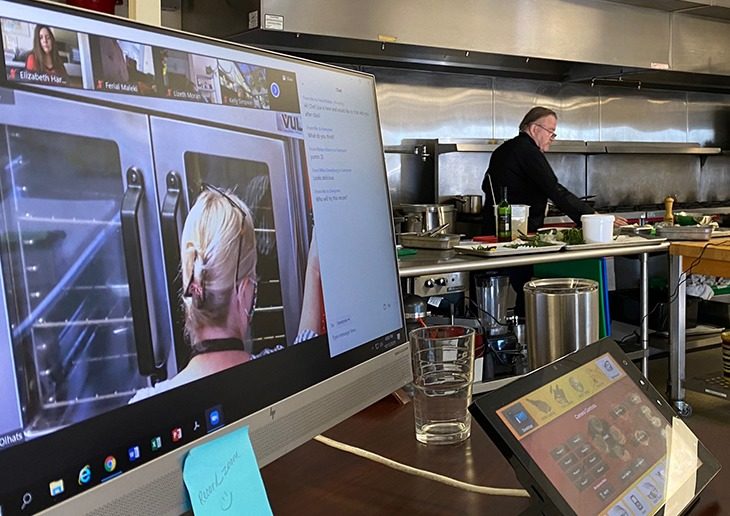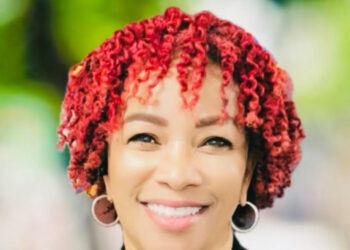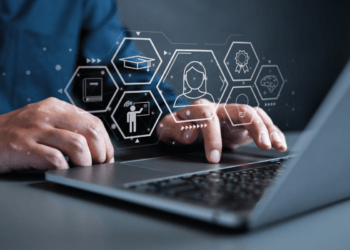Saddleback College’s New Webcasting Tech Keeps Career Education Classes Hands-On Programs
October 30, 2020

It is one thing to teach a student a math formula in an online setting, and quite another to teach someone how to virtually make a merengue. But this is exactly the dilemma that is facing community college career education programs across the country. In addition to the curricular and logistical challenges created by the COVID-19 pandemic, career education programs face the additional difficulty of continuing to provide the hands-on training students need to be successful in their respective fields. This summer, Saddleback College figured out how to do it.
Back in spring, as colleges were first dealing with the uncertainty being created by the growing pandemic, Saddleback’s vice president for instruction, Tram Vo-Kumamoto, was already realizing they had a problem.
“It’s always about student success at Saddleback and making sure that we can give the best experience possible to students either on campus or at home. So, that’s where the idea came from,” recalls Dr. Anthony Maciel, Saddleback’s director of technology services and broadcast systems. “Back in spring, it didn’t take long for professors to start saying, ‘Hey, I really can’t teach my culinary arts or CPR and hands-on classes like that from home because I need all of the professional tools that I have in the lab classroom.’ So by the time summer was starting, our VP for instruction was already saying, ‘We need to address this, and how can we make it happen?’”
What Maciel made happen in the span of a few short months is nothing less than an educational miracle—thirty-two 4K video cameras and dozens of microphones were installed in 16 classrooms and integrated with the latest artificial intelligence and audio-visual integration software so that professors could teach and livestream their classes online all with the click of a button. While this technology isn’t technically “hands-on,” it does provide the closest thing to in-person instruction that is possible, giving professors the ability to demonstrate important skills in a live setting—a critical component of many career education courses.
Now, career education courses like fashion, interior design, culinary arts, health and science, nursing, and emergency medical technician boast the latest webcasting technology available, as do such courses as physics, astronomy, chemistry, orchestra, dance, business, and economics, making these Saddleback classrooms some of the most advanced in the region.
“When the college shut down, all classes went online,” recalls Lisa Inlow, department chair of Saddleback’s Culinary, Hospitality, Travel & Tourism department. “This created a challenge for the hands-on, lab portion of our culinary arts classes. The new technology was installed just as our Fall classes began—it has been great to be back in the kitchen demonstrating via Zoom and even sometimes inviting our students to cook alongside our chef instructors.”
Maciel started by researching how other colleges like UCSD, UCI, and UNLV had done similar things. It was through this research that Maciel learned that webcasting technology, with the integration of artificial intelligence, could provide an almost seamless live teaching experience for both teachers and students. Almost immediately, Saddleback leadership was on board and ready to see what Maciel could do.
“They were excited to see if I could make it happen, and I think they were pleasantly surprised when we actually did,” laughs Maciel.
“A few years ago, this wouldn’t have been possible,” continues Maciel. “Either the technology wasn’t there or it was so expensive as to be cost prohibitive. But once I pitched the idea to leadership, I had their full support. This will never replace live classroom settings, but as far as the student experience goes, it gives us the next best thing. It’s really amazing what the cameras can do with artificial intelligence these days.”
To make the idea a reality, Maciel chose Aver for his 4K cameras, a new player on the market that was offering exceptional quality at an affordable price point. More importantly, the state-of-the-art Aver TR311HN and Shure MXA910 ceiling array microphone integrates seamlessly with the Crestron Network Audio Visual System, a cutting-edge audio-visual integration platform that Saddleback was already using on campus.
These “smart” cameras use artificial intelligence to automatically track the professor as he or she teaches and moves around the classroom. By using programmable “zones,” the cameras are able to automatically perform pre-programmed functions as professors move from one area of the classroom to another, giving online students a feeling of “being there” and eliminating the need for a camera operator to zoom in, move the cameras, or change angles. Pre-programmed settings tell the camera when to zoom in, while Shure ceiling array mics capture everything the professor says clearly without him or her ever having to touch an actual microphone.
“The Interior Design department has many studio classes with hands-on lab components that include personal guidance from the instructor and student-to-student interaction,” says Farida Gabdrakhmanova, instructor and department chair of Saddleback’s Interior Design department. “When converting studios to online format during the pandemic, we had to find ways to make remote learning work for our hands-on classes. If Zoom sessions help to interact with students, classroom webcasting technology allows our instructors to demonstrate techniques live as well as record video tutorials and share them with students asynchronously.”
This freedom of movement and clear capturing of sound frees professors to be as natural as possible when they’re teaching, and in many ways gives students a better view of the professor and what he or she is demonstrating than they would have in a real classroom.
Complicating the already near impossible task of identifying, purchasing, and configuring such an advanced setup in such a limited time was the fact that all classes are different—what students need to see in a culinary class is very different than what students need in a sewing class. This meant each class’s setup would have to be customized to take these nuances into account.
To do this, Maciel worked hand-in-hand with professors to make sure this new technology created a classroom experience they would be excited to share.
“In addition to making sure we were getting all the right camera angles,” says Maciel, “it was important that professors understood how to use the technology so they were comfortable with it and able to focus on teaching. There’s always a little fear that goes along with new technology, so it was important to work with them to overcome that.”
To keep the project on time, Maciel brought in Southland Technology, a local tech installer that was already working with Saddleback on an unrelated classroom technology refresh. Once the equipment arrived, three multi-person teams worked round the clock to physically install and integrate each piece of equipment so it would be ready for the first day of classes.
So far, integration amongst professors has been so seamless, Maciel doesn’t recall having more than a couple issues, none of which have been major. The fact that Maciel and his team can diagnose and address issues remotely means whatever issues do arise, they’re just a few clicks away from being resolved.
In addition to helping professors overcome some of the pedagogical obstacles created by COVID, Maciel is excited about the added value that this technology has created.
“The benefit to our department is great!” says Inlow. “We have been able to continue to teach our classes. Students who are on a timeline and need to complete our courses have been given that option. Moving forward, the use of this technology will allow for more hybrid classes and possibly some 100% online regional classes.”
Gabdrakhmanova agrees and sees similar future benefits: “When we return on campus, webcasting might be a solution to combine online and on-campus students and stream classes in action with the possibility to expand the geography of our students. I think on-demand video lectures will become a norm by leaving class time for collaboration and interaction and improving the quality of education.”
Going forward, Maciel is looking forward to adding similar technology to more of Saddleback’s classrooms by Spring 2021.
“I can tell you that a lot of our professors are already thinking, ‘Hey, this is the way to go,’” says Maciel, whose doctorate is in higher education leadership from USC. “This again goes back to student success and the fact that everybody has different ways of learning. Some people just watch it once and they get it, but not everyone is like that. But if you can record the whole session, why not capture that and make it available to your students, so they can go back and review it whenever they want? Now, students have the ability to review a lecture as many times as they need. The overall aim is to take advantage of technology that will make our students more successful.”
For more information about Saddleback College’s many career education programs, including Culinary Arts, Interior Design, and those in Health, please visit https://careereducation.saddleback.edu/.




